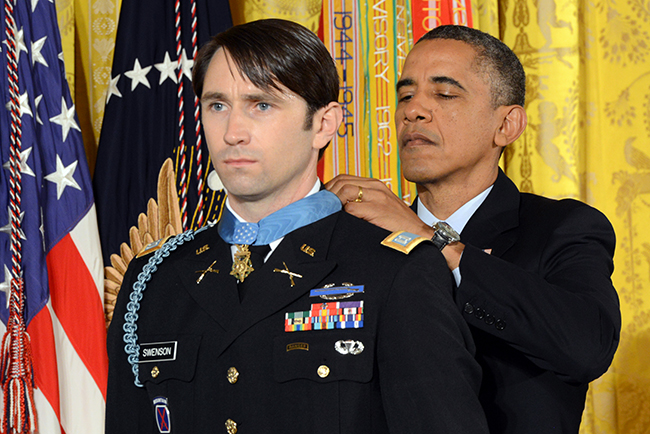Recently, I re-watched a TED Talk by Simon Sinek titled, “Why Good Leaders Make You Feel Safe.” In it, Sinek discusses different approaches to leadership, as well as the consequences, for the team and the leader, of these approaches.
Sinek opens the talk relating the story of former U.S. Army Captain William Swenson, who was awarded the Medal of Honor for actions during a six-hour battle following a deadly ambush in Afghanistan.
Former Army Capt. William D. Swenson received the nation’s highest military award for valor, the Medal of Honor.
Capt. Swenson chose to value the safety of his men over his own. He made that choice daily, so when the moment came in battle, his habits became his actions, and this reflected his character. For Swenson, that day in Afghanistan was the result of choices he made every day. As Sinek says, “When a leader chooses to sacrifice to make people feel safe, remarkable things happen.”
What does it look like to make people feel safe?
Sinek makes the point that it’s easy to assume good leaders are just better people. Maybe Captain Swenson joined the military because he is just a better person. No, Sinek says, that may be true, but it’s not the reason. While Swenson and other military volunteers may, indeed, be great, service-minded people, they do not accomplish great things because of, inherently, who they are. They accomplish great things because they foster an environment of trust and cooperation.
How? We know that simply printing: “trust me” in an employee manual will not deliver results. Trust is a response. It’s a choice people make based on a feeling supported by evidence of trustworthiness. People trust because they are operating in a team that makes them feel safe, regardless of the circumstances around them.
John Maxwell calls this the “Law of Environment.” In describing this Law, John says, “To grow to our full potential, we have to be in the right environment. Growth thrives in favorable conditions. You and I grow the most when we surround ourselves with people and opportunities conducive to our development.”
The Trust Factor
Creating an environment that makes people feel safe is not about removing obstacles or making things easy. Captain Swenson and his team certainly did not have it easy. It’s about providing resources and building trust. In business, there are too many things working against us for it to ever be easy. Competition, market shifts, challenges with staffing, supply shortages, cost increases, human error…
We have no control over these factors, yet we will still face them.
The environment we foster, as leaders, will either encourage our team to face these challenges with confidence, in us, themselves and each other, or will make it more likely for them to be sidetracked by worry or fear.
The Responsibility Paradox
In the video, Sinek recounts an episode of very poor customer service he witnessed. When challenged as to why the employee was treating the customer poorly, the employee suggests she would upset her management if she didn’t follow protocol.
Everyone knows retaining a customer is better and cheaper than winning a new customer. Yet most of us have been in a situation where we witnessed – or received – substandard customer service, because the person providing the service was worried about the consequences of going off script to help the customer.
How does this happen? How do we end up in situations where poor customer service is preferable to problem solving?
Often, this happens because people are more afraid of failing their leaders than they are of failing the customer. In this scenario, most people will choose to “get rid of the customer” instead of going off script to address the challenge upsetting the customer.
If we ask their manager if service is important, it’s very likely the answer would be an emphatic: “Yes!” Well, if that’s the case, what is causing this responsibility paradox? What creates a scenario where a manager wants an employee to serve the customer, yet, in the mind of the employee, customer service would contradict self-preservation.
The answer, in many cases, is an environment where new ideas and deviation from protocol are answered with condemnation, rather than affirmative coaching.
If any shift from the script is apt to get you fired, when an unusual situation happens, the employee will be paralyzed between their internal moral drive to help and their external fear of making a, potentially final, mistake.
John says, “Encouragement is like oxygen to the soul, everyone needs it.” That’s true, and so is the opposite: Condemnation starves the soul of what we need to thrive.
What if they miss the mark?
Fair question. There will be times, when offered the opportunity to Make The Call, your team members flub it. As a leader, this offers you an opportunity to make a choice.
If you choose to focus on the failure, your team member will come away convinced your perception of them is that mistake. They will begin to doubt themselves and look for ways to avoid further condemnation. And that’s how you end up with people who are so afraid to deviate from the norm, they offer the kind of service that motivates your customers to choose the competition.
However, if you choose to use the mistake as an opportunity to coach them up, to reaffirm your confidence that they will learn from this mistake and make the right call next time, your team member will come away excited to prove themselves, and prove your confidence in their ability. Making this choice reflects your trust in them and reinforces their trust in you to affirm their value to the team.
An environment built through this exchange of trust will transform the way your team thinks, how it faces adversity, and how the members interact with each other. Instead of freezing up in the face of a challenge, your team will enthusiastically innovate, working together to solve that challenge.
In our next blog, we’ll continue to explore the connection between leadership and environment by exploring how environment facilitates or teamwork.
*Army News Service photo by Lisa Ferdinando
+Sinek image a screen shot from TED Talks



0 Comments